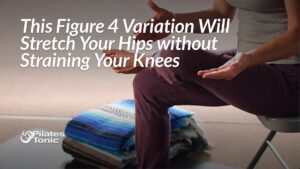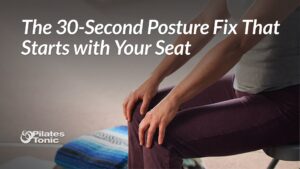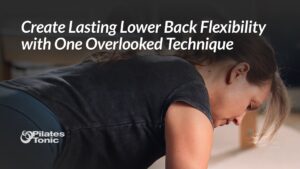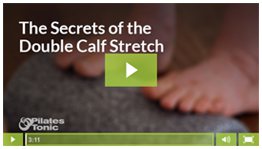 If you suffer from a chronic dull ache in your low back, I’ve got a simple solution that could help that ache go away forever.
If you suffer from a chronic dull ache in your low back, I’ve got a simple solution that could help that ache go away forever.
But before I get to the solution, take a second and check out how you’re sitting as you read this right now.
Is the majority of your weight on the backside of your pelvis (like Will in the photo above)?
If your answer is yes, then you may have just located the source of your low back ache.
How you sit has a huge impact on the health of your spine, especially considering the amount of time many of us spend sitting everyday.
Visualizing the Best Way to Sit
You’ve got three bones that make up your pelvis: two ilia and one sacrum. On the bottom of each ilium is a bony knob, like a little foot. These “feet” are commonly referred to as your sitting bones because they are designed for you to sit on.
Your sacrum is wedged between your ilia and creates a solid support base for your spine. At the bottom of your sacrum is your tailbone.
Think of your pelvis as a pedestal that supports your spine and your sitting bones are the feet the pedestal stands on. When you sit balanced on your “sitting bone feet” this allows your spinal curves to easily align on top of your sacrum.
If you sit behind your sitting bones instead of on top of them, you’ll be leaning your weight onto your tailbone, which wasn’t designed to bear the weight of your body.
Don't Lean Back!
Sitting by leaning onto your tailbone tilts your pelvic pedestal. When your pedestal tilts backwards your spine is no longer able to align and you’ll have to stick your head forward to balance so you don’t topple over backward.
If you sit leaning back on your tailbone on a regular basis your low back is eventually going to ache. You also won’t be able to breathe very well, and the back side of your pelvic floor will become tight. This creates imbalance in the pelvic floor and nothing good can come from that!
It’s pretty evident to me that most car seat, sofa and chair makers are accustomed to sitting on their tailbones instead of their sitting bones because that is how a lot modern furniture and car seats are designed. They are even considered luxurious and comfortable.
Unfortunately, these so-called comfortable items exacerbate low back pain.

A Three-Hour Back Pain Tour
Recently I took a three-hour road trip and drove my husband’s car. I was amazed by the position his car’s bucket seat wanted to put me in.
The shape of the seats was such that my knees were higher than my hips with my weight on my tailbone and the headrest pushing my head out in front of my body.
It was not comfortable at all! I had to roll up an empty bag I had in the car and put it behind my low back so I could attempt to get on top of my sitting bones.
Living on the backside of my sitting bones is an old pattern for me. Ever since I created a new habit of sitting on top of my sitting bones, I’m extremely sensitive to chairs that try to push me back into that old pattern.
Try It In Your Body
Sit on a hard surface with your feet flat on the floor and find your sitting bones. Sometimes it helps to move the flesh of your bottom out of the way when first finding them.
Once you’ve found your sitting bones, feel the weight of them on the surface where you’re sitting. Do they feel evenly weighted beneath you?
Imagine your sitting bones are like feet underneath your body, so now you’re standing upright on your sitting bone feet.
Next, let your weight rock back onto the backside of your sitting bones and notice what happens to your spine and your head.
Then let your weight rock forwards to the very front of your sitting bones. What happens to your spine? Your head?
Now sit so that you're balanced and upright on your sitting bones and imagine they are pointing straight down. Once again, notice what happens to your spine and your head.
Which position allows you to more easily align your spine and sit up tall?
Do This Every Day for a Month
Take this awareness of your sitting bone feet with you every time you sit down. If you’re used to sitting and leaning on your tailbone, it may feel awkward and unnatural at first to sit on your sitting bones.
As you get used to sitting this way, you’ll find leaning on your tailbone when you sit is uncomfortable and you may even find yourself annoyed with the furniture and car seat manufacturers like I’ve become!
More importantly, once you change your sitting posture for long enough, you should notice that chronic aches and pains in your low back, neck and shoulders may have either diminished, or completely disappeared.
Have you changed the pattern in your body from sitting on your tailbone to standing on your sitting bones? Id’ love to hear your experience, especially if you have a favorite visualization that helped you make the change!
Yours in aligned spines and balanced hips!
Sydney





4 Responses
Great article Sydney. I think all to often we don’t think about how we sit, stand or even walk. It’s a rote movement in our brain. By having some mindfulness behind (or should I say under)how we sit is like a light bulb going off in my head. thanks!
Thanks for your feedback Susie! I’m glad you found the article helpful 🙂
As a middle school “Computers” teacher, I see so many kids, who by the age of 11, are already complaining of back pain. They sit with their hips waaay forward in their chairs, lean back, then crane their necks to see the monitor or computing device. Now they have a double-whammy, which includes “shoulder” pain, which is actually the top their poor little spines trying to bend far enough to compensate! I can’t wait to show them the comparison mechanics photo the next time they ask “why do you make us sit up straight?” Thanks!
I think people would be astonished by how many back problems could be remedied and prevented by simply changing how we sit…especially in kids! Thank you for your feedback Matthew!